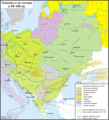Plik:Slav-7-8-obrez.png

Rozmiar podglądu – 544 × 599 pikseli. Inne rozdzielczości: 218 × 240 pikseli | 436 × 480 pikseli | 698 × 768 pikseli | 930 × 1024 pikseli | 1860 × 2048 pikseli | 3051 × 3359 pikseli.
Rozmiar pierwotny (3051 × 3359 pikseli, rozmiar pliku: 339 KB, typ MIME: image/png)
Historia pliku
Kliknij na datę/czas, aby zobaczyć, jak plik wyglądał w tym czasie.
| Data i czas | Miniatura | Wymiary | Użytkownik | Opis | |
|---|---|---|---|---|---|
| aktualny | 17:13, 12 sie 2023 |  | 3051 × 3359 (339 KB) | Gyalu22 | Reverted to version as of 13:16, 23 October 2022 (UTC) Look at the atlas, don't do your own research |
| 19:43, 1 cze 2023 |  | 3051 × 3359 (309 KB) | Shibbolet3579 | enice was still in the Byzantine Empire at this time. Avars were also present around Vienna and in central Transylvania, evidenced by graves & toponyms. There was a linguistic contact between Albanians and Vlachs, evidenced by the non-Slavic words present in both languages. Placed the Etelköz of the Magyars and the Crimean byzantine Greeks. South-Slavic toponyms (as Trnava for "tip, hillock, mound") evidenced a South-Slavic presence in southern Transylvania. Concerning the Eastern romance spe... | |
| 15:16, 23 paź 2022 |  | 3051 × 3359 (339 KB) | Gyalu22 | Reverted bad faith edit, restored to version as of 26 July 2011. The Westermanns Atlas is an irrelevant source for the previous map, as only the Southern Carpathians are shown as possibly inhabited by the Wallachians. | |
| 17:09, 28 kwi 2014 |  | 3051 × 3359 (302 KB) | Spiridon Ion Cepleanu | Bulgarian kingdom & east-romance vlachs according with the universitary atlases of history and the Grosser Atlas zur Weltgeschichte, dir. Hans-Erich Stier, Westermann, 1985, ISBN 3-14-10-0919-8, pp. 50, 55-57, 61 & 64. | |
| 20:27, 26 lip 2011 |  | 3051 × 3359 (339 KB) | Koryakov Yuri | The map's resolution is drastically decreased. Undo | |
| 06:53, 26 lip 2011 |  | 544 × 599 (329 KB) | Spiridon Ion Cepleanu | On the original version of this map, the eastern romance language-spoken populations ("Vlachs" or "Volokhs") are draw only in a little area around Sredets (today Sofia), according with only one of the POVs, called "Röslerian" (since Eduard Robert Rösler | |
| 15:52, 10 mar 2008 |  | 3051 × 3359 (339 KB) | Koryakov Yuri | {{Information |Description= |Source= self-made |Date=March 2008 |Author= Koryakov Yuri |other_versions= }} == Licensing == {{self|cc-by-sa-3.0}} Category:Maps of the history of Russia in Russian [[Category:Maps |
Lokalne wykorzystanie pliku
Następujące strony korzystają z tego pliku:
Globalne wykorzystanie pliku
Ten plik jest wykorzystywany także w innych projektach wiki:
- Wykorzystanie na ar.wikipedia.org
- Wykorzystanie na arz.wikipedia.org
- Wykorzystanie na azb.wikipedia.org
- Wykorzystanie na ba.wikipedia.org
- Wykorzystanie na be-tarask.wikipedia.org
- Wykorzystanie na be.wikipedia.org
- Wykorzystanie na bg.wikipedia.org
- Wykorzystanie na ce.wikipedia.org
- Wykorzystanie na cs.wikipedia.org
- Wykorzystanie na cv.wikipedia.org
- Wykorzystanie na da.wikipedia.org
- Wykorzystanie na de.wikipedia.org
- Wykorzystanie na en.wikipedia.org
Pokaż listę globalnego wykorzystania tego pliku.

